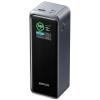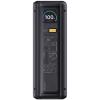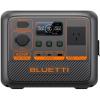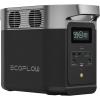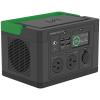Most of us heavily rely on technology to get through the day, whether it’s for work, study, or entertainment. In case of a power outage or scenarios when there’s no power outlet in sight, it’s always worth it to have a portable power solution to keep your devices juiced up.
When it comes to portable power solutions, two main options are power banks and portable power stations. While they operate similarly, there are some very distinct differences between them. If you’re unsure of which one to get, we will help you decide!
What is a Power Bank?



A power bank is essentially a portable charger specifically designed for your everyday essentials. They are compact and lightweight, easily fitting in your bag. Measured in milliamp hours (mAh), their capacity determines how many times they can charge your device.
They typically offer a few USB outputs, making them ideal for topping up smartphones, tablets, or other smaller electronics on the go. Think of them as a convenient pocket-sized power source to keep your devices juiced up throughout the day.
At PB Tech, we sell a wide range of power banks, with capacities ranging from 5,000mAh (suitable for charging your smartphone and/or earbuds once or twice) to 30,000mAh (capable of charging smartphones, tablets, and handheld gaming devices many times over). Read more about our Top Power Banks over here. Or check out Power Banks: How to Pick the Right Capacity for Your Needs.
What is a Power Station?



A portable power station is essentially a large battery that you can easily take with you. If you need a powerhouse for serious charging needs, a portable power station is your answer. These devices boast a significantly larger capacity measured in watt hours (Wh), allowing them to handle high-wattage devices like laptops, cameras, and even some appliances.
Portable power stations are equipped with various ports (AC, DC, USB) to charge a multitude of devices simultaneously. Some even offer advanced features like solar charging. While they’re less portable than power banks, their versatility and greater power capacity make them ideal for camping trips and outdoor adventures, or keeping at home in case of emergencies or power outages.
PB Tech sells a range of power stations to power up your entire arsenal of electronics. Our smaller capacity options are perfect for powering up essential electronics and small appliances for your camping trip, while our larger capacity power stations are capable of powering up even larger appliances, like refrigerators.
Before we go further, a quick pit stop:
Understanding mAh vs Wh: How to Compare Capacities
Power banks are usually rated in mAh (milliamp hours), while portable power stations are rated in Wh (watt hours). These units measure capacity in different ways, but you can convert between them using this simple formula:
Wh = (mAh × V) ÷ 1000
Most power banks use a voltage of 3.6V, so for example:
10,000mAh × 3.6V ÷ 1000 = 36Wh
This helps put things into perspective - while a small power station might have a 300Wh capacity, a typical 10,000mAh power bank holds only around 36Wh. That’s why power stations are better suited for running larger devices or keeping things going for longer periods.
What are the key differences?
Okay, now that we've got the maths out of the way, the first step is understanding what sets power banks apart from portable power stations.
Portability
- Power banks are champions of portability. They're typically compact and lightweight, easily fitting in a purse, backpack, or even a pocket.
- Portable power stations, on the other hand, prioritise power over compactness. They tend to be larger and heavier, making them better suited for situations where you have a designated carrying space, like a car or camping bag.
Output
- Power banks are measured in milliamp hours (mAh), as we touched on earlier. They're ideal for topping off smartphones, tablets, or other smaller devices with lower power requirements.
- Portable power stations, however, are measured in watt hours (Wh), boasting a significantly larger capacity. This translates to powering devices with higher wattages, like laptops, cameras, and even some appliances.
Versatility
- Power banks typically offer just a few USB outputs for charging low-power devices.
- Portable power stations are the ultimate multitaskers. They come equipped with various ports (AC, DC, USB), allowing you to charge a wider range of devices simultaneously. Some even boast additional features like solar charging capabilities or the ability to act as a power source while being recharged themselves (pass-through charging).
Charging Options
- Power banks are recharged using a standard wall adapter.
- Portable power stations offer more flexibility. Depending on the model, they can be recharged with a wall outlet, car charger, or even solar panels, making them ideal for off-grid situations.
What Option Should You Choose?
Now that we're clear on the key differences, it's also clear which scenarios each is best for. This is what we recommend:
Power Bank
If you primarily need to charge smartphones, tablets, or other small electronics on the go, a power bank is a perfect choice. Their portability and focus on low-power devices make them ideal for everyday use. They're also a great option if you prioritise a lightweight solution for occasional charging needs.
| Pros | Cons |
|---|---|
|
|
|
|
|
Portable Power Station
If you need a more robust power source, a portable power station is the way to go. They're a great choice for powering laptops, cameras, drones, or other high-wattage devices. If you love going on camping trips or outdoor adventures, this is also the prime choice! Additionally, you can rely on a power station to provide a long-lasting power solution during emergencies. The ability to power multiple devices simultaneously and the wider range of recharging options also adds great versatility.
| Pros | Cons |
|---|---|
|
|
|
|
|
Power banks and portable power stations are both valuable solutions for staying powered up on the go (or even at home). They both serve best in different scenarios so you might even find it worth it to have both of them! Head over to PB Tech to browse our full range of Power Banks and Portable Power Stations.










